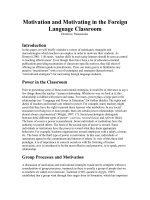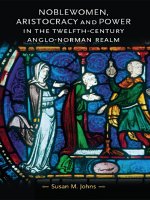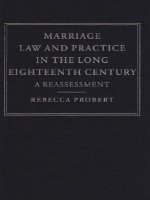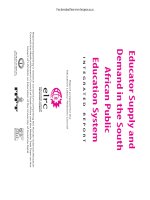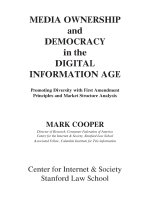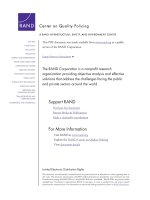Malay stereotypes acceptance and rejection in the malay community
Bạn đang xem bản rút gọn của tài liệu. Xem và tải ngay bản đầy đủ của tài liệu tại đây (1.74 MB, 141 trang )
MALAY STEREOTYPES: ACCEPTANCE AND REJECTION
IN THE MALAY COMMUNITY
NOORAINN BINTE AZIZ
(B. SOC. SC (HONS), NUS)
A THESIS SUBMITTED FOR THE DEGREE OF MASTER OF ARTS
DEPARTMENT OF MALAY STUDIES
NATIONAL UNIVERSITY OF SINGAPORE
2009
ACKNOWLEDGEMENTS
This thesis would not have been possible without the insights, direction and
support of a number of people. My deepest appreciation and gratitude to;
My husband, Mohd Azhar bin Terimo, for his invaluable sacrifices,
support and faith in me.
My advisor, Assoc. Prof Syed Farid Alatas who is always helpful and patient and whose
astute observations allowed for a much greater contribution for this thesis.
Dr. Noor Aisha Abdul Rahman, Dr. Maznah, Assoc. Prof. Jan Van Der Putten, Dr. Syed
Muhammad Khairudin Aljunied, Dr. Azhar Ibrahim, Kak Ras, Kak Dahlia and
especially to Dr. Suriani Suratman for her indispensable guidance on the
direction this thesis finally took.
My parents, Aziz bin Yusoh and Monah binte Abdul Rahman
My siblings, Kak Long, Anga, Abang Zul and especially to Kak Bibah and Kak Liz who
helped to care for my two children while I was buried in books.
Kak Nap, for the many hours spent proof-reading this work.
My post-graduate classmates at the Department of Malay Studies,
friends who shared, encouraged, comforted and served as my unending sounding
board during my whole journey.
And last but definitely not the least,
All my interviewees, whose participation is key.
ii
For My Two Children;
Luqman Naqib Bin Mohd Azhar & Huda Umairah Binte Mohd Azhar
iii
Contents
Acknowledgements
ii
Dedication
iii
Abstract
vi
Tables & Abbreviations
vii
Quote
viii
1
2
3
4
The Phenomenon at Hand
1
Working Class Problems as Malay Problems
Focus of Study
Method
Delineating „Stereotype‟ & „Ethnicity‟
Chapters Abridged
4
8
10
11
12
The ‘Deficient Malay’ Debate
14
Invention of the Deficient Malay Character
A Colonial Legacy Continued
Opposition to the Inherently Deficient Malay
Cultural Deficit Versus Impeding Social/Economic Structures
Studies on In-Group Stereotype
14
18
32
35
38
Methodological Approach
43
The Field
Defining „Malay‟
Class Classification
Findings
43
45
51
53
‘Success-centrism’
60
Stereotype and Self-Deprecation
Infiltration of Ideology
Class and Self-Deprecation
Role of Berita Harian
„Other Malay Problems‟
Impact of Journalists
60
61
63
74
77
78
iv
5
6
Malay Values Sinicized
80
Cultural Deprivation
A Pigeonholed Community
Brown Skin, Yellow Masks
Melayu Baru („New‟ Malay)
80
82
83
94
The Incarcerated Malay
101
The Colonial Marvelled
„Tak Boleh Dapat Punya‟ (Cannot Get For Sure)
101
103
Conclusion
114
Bibliography
117
Appendices
127
1
Participant Information Sheet
127
2
Participant Consent Form
128
3
Participant Details Form
129
4
Interview Protocol for Semi-Structured, In-Depth Interviews with 130
Interviewees
5
Samples of Banners Community Centres Displayed
131
6
Samples of Community Centres‟ Courses/Activity Schedules
132
v
Abstract
Challenges faced by communities on the peripheries have been much dealt with
and the Malays in Singapore are no exception. Due to their relatively slower socioeconomic progress, there is an enduring interest in the study of Malays. Of particular
significance to this study are allegations of Malay „cultural deficiencies‟ made by the
significant few. This study revisits some of the more prominent works pertaining to this
claim and embarks on field research to enquire into the extent the claims of Malay
„cultural deficiencies‟ have infiltrated the common Malay.
As a backdrop, works by leading thinkers which looked at possibly similar
phenomenon in other social contexts were used as guide on possible findings on the
field. This study found that the Malays have internalized allegations of their „deficient
culture‟ and that the damaging impact of such a belief on the community‟s self-esteem
has already led to sentiments of self-hate and a desire to abandon their culture for a
supposedly „more progressive‟ Chinese culture. Consequently, the community continues
to be labelled as „inadequate‟ leading to sentiments of prejudice and internal
discrimination within the community itself.
vi
Tables
3.1
Malay „ Cultural Deficiencies‟ (Dual Class Classification)
55
3.2
Goldthorpe‟s Class Scheme (Original version)
56
3.3
Malay „Cultural Deficiencies‟(Goldthorpe‟s Class Classification)
57
Abbreviations
BH
Berita Harian
NEP
New Economic Policy
PAP
People‟s Action Party
ST
Straits Times
UMNO
United Malays National Organisation
vii
‘Pada Masa Satu Bangsa Menghina Dirinya,
Pada Masa Itulah Bangsa Lain Akan Menghinanya’
(The Moment a Race Humiliates himself, That is when Others Humiliates him.)
Meng Tse1
1
(approximately 300 years B.C in Alatas, 1972)
viii
1
The Phenomenon at Hand
“….the colonizer had constructed a „mythical and degrading portrait‟ of
the colonized that the latter ended up accepting and living by to a certain
extend”.
(Memmi, 1965:87 in Verges, 1996:92)
This thesis was triggered when my fellow Malay colleague censured Malays as a
community which „cannot make it, lah!‟ to our non-Malay co-worker before advising her
to find a non-Malay candidate for her project. Her comment astounded me because she
was enjoying her recent promotion into middle management and thus did „make it‟. It
propelled me to engage other close Malay friends on issues about Malays. A conclusion
by one left a lasting impression on me. She said,
“Melayu memang gitu apa, malas… macam mana nak naik!”
I realised that ethnic prejudice (Allport, 1979:9) held by Malays of themselves
was possibly a widespread phenomenon. Having spent my entire life in multi-ethnic
Singapore, stereotypes - negative or positive of the various ethnic groups - were abound
but these were usually by others unfamiliar with the practices of another. Negative
stereotyping is primarily rationalisers (Allport, 1979:204) for sentiments of prejudice and
acts of discriminations and throughout this thesis, the relationship among these three
1
words holds true. In the United States, racial discrimination against African-Americans
by White Americans2 led to ethnic movements like the African-American Civil Rights
Movement carrying slogans like Black is Beautiful and Black Power (Lily, 1998:52).
Among the French colonies, Négritude3 came into being as artillery against French
racism. These are examples of protests by communities who were well aware of ethnic
prejudices held against them by other ethnic communities and reacted in self-defence.
Although this consciousness was found to be present among the Singapore Malays, it has
yet to bring about outright protests. The Malays concur that ethnic prejudices against
them by themselves was exactly as Frantz Fanon described in his famous book- Black
Skin, White Masks (2008).
If that was true of the Singapore Malays, then the
psychological impact on them is unimaginable and immeasurable. The control of the
mind is the ultimate form of control (Lily, 1998:52). If Malays look at themselves
„through the eyes of others‟ (Du Bois, 1969:115 in Lily, ibid), it will imprison their
minds (Baker, 1983:41 in Lily, ibid). Hence, this study undertook to investigate the
extent of Malays‟ prejudices against themselves. Crucial to this study is the prevalent
negative perceptions Malays held about their community i.e. stereotypes which could be
the basis for their prejudices.
Preliminary enquiry into negative perceptions of Malays boiled down to one
single factor – the relatively slower socio-economic development of Malays compared to
other ethnic groups, especially in Singapore where the progress of each ethnic group is
2
Source: „African-American Civil Rights Movement (1896–1954)‟, retrieved 20th July 2009 from
/>3
Source: „Négritude‟, retrieved 20th July 2009 from />
2
chartered on an annual basis4. Considerably, this slower Malay socio-economic progress
had been attributed by segments of Singaporeans in the community to their „deficient
culture‟ i.e. lazy, non-priority towards education, unpersevering which at times, are even
indicative of inherent biological flaws (Mahathir: 1970, Wan Hussin: 1990, Za‟ba: 2005,
Senu et al: 2004).
In his book „The Myth of the Lazy Native‟ (1977), Syed Hussein Alatas argued it
was colonisation of the Malay Archipelago which initiated the „ideological denigration
of the native and of his history and society‟ (1977:8). By creating the ideology of
laziness (1977:22), it provides the Colonials with the basis for the „necessity‟ to acquire
native territories (1977:23).
Alatas also discussed the writings of José Rizal and
Abdullah bin Abdul Kadir Munshi, intellectual natives who wrote about the indolence in
their communities. They censured different sources for the natives‟ indolence. Rizal
attributed it to the Spaniards, while Abdullah blamed it on the Malay rulers and their
dependents (hamba raja) (1977:137). Alatas demonstrated that the Colonial‟s “native
indolent ideology” was adopted by these two intellectual natives and whose ideas
unfortunately continued to influence other writers till the 20th century – as seen in Malay
Dilemma and Revolusi Mental by Mahathir bin Mohamad and Senu bin Abdul Rahman
respectively, central figures in Malaysia‟s political arena. Lily Zubaidah Rahim‟s The
Singapore Dilemma (1998) also found the ideology of Malay „cultural deficiency‟ a
convenient aversion against criticism of the People‟s Action Party‟s (PAP) supposed
multi-racial and meritocratic system (1998:3). This is supported by the Malay middle
4
Charting of ethnic progress is done because Singapore is run on the politics of race - Chinese, Malays,
Indians, Others categories (CMIO)4 (Clammer, 1985:107,119).
3
class, who had their ego flattered by the PAP leadership as role models of exceptional
qualities (1998:59).
These works provided an indication that negative views by Malays of Malays
may be held by Malays of the upper crust in society, especially because of its ideological
functions though other members may hold similar views, as my experiences described
earlier, hinted that such adverse ideas may have permeated further down within the
community which would be cause for disquiet.
Working Class Problems as Malay Problems
Currently, Malays make up approximately 13.6%5 of Singapore‟s total
population. Socio-economically, in education and politics, Malays have been known to
be on the peripheries since the onset of colonisation (Lily, 1998:19) and an awareness of
their marginal position in Singapore‟s multi-ethnic society is widespread. In Census of
Population 2000, only 23.35% of the total Malay working population held positions of
senior positions, professionals or associate professionals and technicians compared to a
whopping 46.15% among the Chinese. Their peripheral socio-economic position was
even more glaring inter-ethnically, as Malays make up only 6.28% of the total senior
positions in Singapore. The majority of Malays are members of the peripheries where
there commonly exist „a relative lack of services, lower standard of living and higher
level of frustration‟ (Hechter, 1975:33). To the dominant PAP government, problems
faced by Malays including drug addiction, high divorce rate and the inability to complete
formal education, were attributed not to socio-economic constraints, which were
5
Yearbook of Statistics Singapore, 2009.
4
incidentally quoted by my working class interviewees, but to the alleged Malay „cultural
deficiency‟.
Conservatives like Banfield (1974) and Murray (1984) defended cultural thesis as
the basis for the community‟s lack of progress claiming that each social class exhibits a
pattern of attitudes, values and modes of behaviour which inadvertently lead to their
„successes‟ or „failures‟. Banfield stamped members of the „lower class‟6 with deficient
cultures like improvidence, irresponsibility, inability or unwillingness to control
impulses, unskilled, frequent job movements, instability, a poor husband and father and
violence (Muller,1997: 337). These, he claimed, were rooted from a „single problem: the
existence of an outlook and style of life which is radically present-oriented and which
therefore attaches no value to work, sacrifice, self improvement, or service to family,
friends, or community‟ (Banfield, 1974: 235), a problem he claimed to be culturally
transmitted from generation to generation (Muller, ibid). So entrenched were these
„cultural deficiencies‟ on the „lower class‟, that to Banfield, even if „we could afford to
throw the existing cities away and build new ones from scratch, matters would not be
essentially different, for the people who move into the new cities would take the same old
problems with them‟ (1974:279). This „cultural deficit‟ thesis posits that the raison d'être
of poverty in some communities is due to their deficient culture and that the provision of
„really good‟ jobs would not induce them to change their lifestyles for it is their lifestyles
which repress them from these jobs (Banfield, 1974:266).
The remedy, for the
conservatives at least, was the abandonment of the „deficient‟ lower class culture and
6
Banfield differentiated the „lower class‟ from the „working class‟. The working class did not share the
„deficient culture‟ of the lower class. Among them are the aged, the physically handicapped and mothers
with dependent children (Muller, 1997: 336).
5
„acquir(ing) the attitudes, motivations, habits of the working class‟, something which is
also consistently advocated by the PAP government. This allegedly vanquishes „the
most serious and intractable problems of the city‟ (Banfield, 1974: 235).
The liberals (e.g. Harrington, 1963) also accepted the notion of a „culture of
poverty‟ as limiting the upward social mobility of the poor (Muller, 1997:336), but they
differ starkly from the conservatives. To the liberals, ethos of the poor resulted from
living in environments clamped with various socio-economic impediments which may
result in problems like alcoholism.
The solutions for this included governmental
intervention in education, training programmes and creation of greater opportunities for
poor children (Muller, 1997: 335-336). The conservatives alleged that these solutions
would create a welfare or crutch mentality, more crimes, single-parent families (Murray,
1984 in Lily, 1998:51), threatening the well-being of the free market economy (Lily,
ibid), encourage paternalism and deter responsibility and initiative (Murray, 1984).
The PAP government consistently claims that the relative impoverishment of the
Malays is due to their „cultural deficit‟ which, to Lily (1998:51), was a convenient way
to position the „problem‟ within the Malay community as it „disentangles the
significance of structural, institutional and historical factors in contributing to their
poverty‟ (ibid). Consequently, they have adopted a minimalist attitude towards the
socio-economic and educational malaise confronting the Malay community (Lily,
1998:19). Instead, they promote to reform their „deficient culture‟.
6
The PAP government has to date, unfailingly accentuated the problems facing the
Malays by associating them to their „deficient culture‟. This is most prominent during
the Prime Minister‟s speeches at National Day Rallies. In 2005, Prime Minister Lee
Hsien Loong said,
“Mereka tiada kemahiran atau kerja tetap.
Mereka berhenti
sekolah sebelum tamat pendidikan menengah. Ramai yang menganggur,
dan mempunyai anak-anak kecil yang tidak mampu mereka tanggung…
Ia menjejas masyarakat Melayu lebih daripada India atau Cina kerana
lebih ramai pasangan Melayu yang berkahwin muda dan bercerai awal…
Kita perlu bantu keluarga-keluarga ini supaya dapat berdikari… tetapi
lebih penting memberi bimbingan untuk mengubah sikap dan cara hidup
mereka.”7
(Prime Minister Lee Hsien Loong)
The „problems‟ are largely common to those at lower income levels but they affect
Malays disproportionately, as more of them have low incomes (Li, 1998:166). The
problems are labelled as a „Malay problem‟, fitting the PAP government‟s espoused
rationale of a Malay „cultural deficiency‟. This resulted in the equation of these social
problems to the Malay community (culture) instead of highlighting the socio-economic
structural hurdles faced by peripheral communities and acting on them.
7
Source: />
7
Peripheral communities are rarely conscious of the close relationship between
low income and social problems. Macleod‟s (1995) study of working class teenagers
living in public housing in the United States found that most were unaware of the role of
structure in the reproduction of social inequality and held themselves responsible for
their plight. The same could be said of the working class Malays. My interviewee
Hanif, attributed his difficulties solely to his choice of „bad‟ company in secondary
school although he also spoke about having to work „part-time‟ to pay for his own school
pocket money, which showed that oppressive socio-economic infrastructures are not
recognised. This could only be explained by the PAP government‟s ideology (Lily,
1998:248) of Singapore‟s „society as open and fair and full of opportunity… (and that)
success is based on merit, and economic inequality is due to differences in ambition and
ability‟ (Macleod, 1995:3).
Focus of Study
In a world social order predominantly resting on principles like democracy and
equality, the existence of reductionist grounds to account for poverty in society can only
be pathological. While recognising the importance of a study which proves the validity
of arguments presented by the conservatives and liberals, such an endeavour would be
beyond the confines of this thesis. We are concerned on the extent this pathological state
of mind has infiltrated the common Malays.
In a paper by Sigelman and Tuch (1997), the concept of metastereotypes,
focusing on Blacks‟ perceptions of whites‟ stereotype was explicated.
It was, and
8
perhaps still is, an area under-researched judging from the dearth of such studies. This
study delves at an aspect of social psychology towards that area of research but through
ethnographic lens. Like the contemporary Cajun (2001), whose self-image could be
traced to stereotyped portrayals by outsiders, this study explores the Malays‟ image of
their in-group. Do Malays subscribe to their „cultural deficit‟ ideology? Who amongst
the community would subscribe to it? What functions would it serve? What are the
consequences of such a possibility? Putting these questions together pointed me to the
central overarching question for this thesis, „How do Malays from different social groups
perceive themselves in relation to the cultural deficit thesis?‟ Is it a perception held by
Malays from all levels of the community or is it a view held by certain sections of the
ethnic group? This thesis will look at two main areas.
Firstly, „Do Malays from
different socio-economic backgrounds hold varying perceptions of themselves in relation
to the cultural deficit thesis?‟ Secondly, „What do Malays attribute their failures and
successes to?‟ Judging from works examined (e.g. Mahathir, 1970; Senu, 2004; Wan
Hussin, 1990), the Malay cultural deficit thesis could explain the relatively slower Malay
socio-economic progress to middle class Malays but for working class members, it may
be due to discrimination (Suriani, 2004/05; Lee, 2006: Nurliza, 1986). Valuable also are
perceptions on how Malays acquire a „deficient culture‟.
The Malay elites8 are excluded from this study as such analyses have been
documented elsewhere9. Malay elites (as were the non-Malays) were divided on this
notion of a „deficient Malay culture‟. Although there have been ethnographic studies
8
Elites here defined as „those at the head of the large economic, political and military organisations‟
(Mills, 1959:4 in Hartmann, 2007:41)
9
Refer to Syed Hussein Alatas (1977), Lily Zubaidah Rahim (1998) & Shaharuddin Maaruf (1988).
9
representing the common Malays‟ standpoint (Li, 1989; Lai, 1995; Stimpfl, 2006;
Nurliza Yusuf, 1986), these do so in a homogeneous manner. Lai (1995:59) found that
perceptions of Malays as „friendly, tolerant, gracious, easily contented, and family
oriented‟ are held by Malays themselves. But which Malay social group views their
community as such? It would be absurd to claim that these perceptions apply to the
whole community. There exists a lack in Malay perception studies of themselves, as the
diversity in the community has yet to be addressed. This thesis attempts to represent the
multiplicity of common Malays from various socio-economic backgrounds in their
perceptions of Malays in relation to their alleged „deficient culture‟. This is crucial if
one considers the interplay between the social and economic factors which often form
the basis of one‟s perceptions.
Method
This study aims to understand how Malays perceive themselves. A qualitative
approach was thought best for its in-depth information. I have examined a variety of
works pertaining to Malay socio-economic development, including that of literary works,
in order to gather information on the perceived „cultural flaws‟ of Malays. Excerpts
from the flagship Malay newspaper Berita Harian were taken over a period of ten
months from December 2008 to determine specific types of Malay „cultural deficiencies‟
which could be historically traced to the Colonials and which are still widespread today.
These helped to surmise possible stereotypes predominant in contemporary Malay
community which facilitated the preparation of semi-structured questions for interviews.
10
Delineating ‘Stereotype’ & ‘Ethnic’
In his book, The Nature of Prejudice (1979), Allport defined stereotype as „an
exaggerated belief associated with a category‟ (1979:191) that rationalises and can be
easily adapted to the prejudicial needs of a prevailing situation (1979:204). Using
Allport‟s definition, Malays as an ethnic group could be identified as the category under
study. Our focus is on the Malays‟ perceptions of themselves and the reasons cited for
these perceptions, which are used to rationalise their relatively slower socio-economic
progress. Instead of „stereotype‟, I use „views‟ (more neutral) during interviews, hoping
that my interviewees will participate willingly in the interviews and also with their views
about Malays. „Views‟ was also unintimidating and is a commonly used word that
interviewees were immediately aware of the aims of my research.
The words, „ethnicity‟ and „race‟ also require elucidating for they are contentious
categories.
„Ethnicity‟ alludes more „to the quality of relations existing between
individuals sharing certain cultural behaviours‟ (Hechter, 1975:312), while „race‟ fixes
„biological traits to a human grouping‟ (King, 2004:1). For the dominant Singapore
government, paternal „racial‟ lineage is endorsed thus denying the role of culture in
identity formation although at the same time, certain cultural practices are assumed to be
Malay – e.g. the celebration of Eid ul-Fitr - although a Muslim religious celebration - is
distinctly recognised as Malay cultural practice. Contradictions between one‟s identity
as written in his/her identity card and actual lived cultural practices also arise. An
individual may have a Chinese father and Malay mother, follows Malay cultural
practices but is still legally identified as a Chinese. For the purposes of this study, the
11
Malay „ethnic‟ group is preferred because it emphasises on lived practices and also
considering that criticism against the Malays is towards their „deficient culture‟. During
interviews, „race‟ was used interchangeably mainly due to its familiarity on the ground.
Chapters Abridged
This thesis is much influenced by data gathered on the field and to appreciate
them, the chapters are assembled such that readers will get a sense of the debates
surrounding the relatively slower socio-economic progress of the Malays and allegations
of „deficiencies‟ they suffered first before presenting my research findings.
This chapter acquaints us on the cultural deficit thesis and how working class
Malays become depicted as afflicted with this deficiency. This is followed by a review
of relevant works concerned about the socio-economic progress of Malays and on Malay
„cultural deficiency‟ allegations (chapter 2). Studies focusing on in-group stereotypes
are also discussed. These help pave the way for this study. Chapter 3 delves into our
research proper by first discussing the approaches undertaken for data collection
followed by fieldwork findings. A discussion on the definition of who is „Malay‟ is also
included so as to elucidate the community at the heart of this thesis.
Chapters 4 and 5 make up the analysis chapters of this thesis. They discuss the
causes and effects for Malay internalisation of negative self-images of themselves,
specifically „success-centrism‟ (i.e. belief in one‟s capability, work etc. superiority), selfhatred and forthright yearning to „liberate‟ Malays from their „deficiencies‟ and embrace
12
the supposedly more „progressive‟ cultures of the Chinese.
This indicates that the
psychological subordination of Malays which ethnic minority writers like Frantz Fanon
(2008), Malcolm X (1965) and William Du Bois (1965) feared for marginalised
communities has long been under way among the Malays.
Indicative also is the
breakdown in ethnic solidarity and pride (Bonacich, 1980:584 in Lily, 1998:53).
Finally, an association is made between PAP as successor of the British Colonials
and their perpetuation of the Malay „cultural deficiencies‟ ideology. This would account
for the continual discriminatory practices as disclosed by interviewees, thus alluding
them to the prison created by these allegations which have kept them in the state of
relative impoverishment.
As this study is qualitative in nature, the results attained cannot be assumed to be
representative of the Singapore Malay community. What it does offer are instances
taken from a small sample of the Malays which could be representative of a possible
pathological psyche invading the community‟s perception at large.
13
2
‘The Deficient Malay’ Debate
This research focuses on an analysis of two groups of literature. One involves
studies which looked at the phenomenon of in-group stereotypes, while the other on
works written about Malays, with preference to those works which considered the
development/progress and poverty of the community to be closely inter-twined with
allegations of Malay „cultural deficiencies‟. Also discussed is how the ideology of a
„deficient Malay culture‟ was introduced by the Colonials and its eventual subscription
by factions of the Malay elites. Plausible motivations behind these subscriptions will
also be explicated in this chapter.
Invention of the Deficient Malay Character
Alatas argued that the British Colonials instituted the idea of the „flawed‟
character of the Malays for political and economic reasons (1977). He said that the
creation of negative Malay character was because the Colonials faced difficulties in
recruiting Malays to work in the „type of slave labour which the Chinese and Indians
were compelled to do owing to their immigrant status‟ (1977:75) in their cash crop
plantations. He explained that the Colonials‟ persistent belief in this idea was because
they did not really get a chance to observe the Malays in their daily activities who
„…plant, ...fish, …build houses,… look after their farms‟ and „are occupied everyday‟
(1977:72), as the Malays were concentrated in rural areas, unlike the urbanised Chinese
and Indians. Alatas also claimed that the idea of the lazy native was generated not by
14
scholars at first but by monks and tourists. Scholars who were prejudiced and arrogant
and who had the unconscious dominance of certain categories of Western colonial
capitalist thought were influenced by this idea of the lazy native. (1977:112). Hence,
they could not appreciate the hardworking Malay tukang arang (charcoal sellers) for it
did not follow the regular pattern of Western work (Alatas, 1977:121), and they
dismissed the tukang arang as not actually doing „real‟ work. The „flawed‟ character of
the Malays was also very often based on the opulence of the Malay Royalty from
isolated incidents (Alatas, 1977:130) but was sweepingly applied to the whole ethnic
group. By labelling the Malays as indolent, the Colonials had a convenient „excuse‟ to
colonise the region with the aim of „civilising‟ the native people.
Charles Hirschman in „The Making of Race in Colonial Malaya: Political
Economy and Racial Ideology‟ (1986) elaborated that before the British‟s complete
control of the Malay Peninsular, the journals of Swettenham (written in 1870s) (Burns &
Cowan, 1975 in Hirshman, 1986) and Low (Sadka, 1954 in Hirschman, 1986), who were
the two earliest pioneers of the British forward movement, were unaware of Malay
capacities and abilities.
Low had described the Malays as „a people so naturally
sagacious and clever [and] whose abilities are probably not inferior to any of the
nations of Europe‟ (Loh, 1969:4 in Hirshman, 1986:344). As the British Colonials had
claimed that their governance was paternalistic in nature instead of conquerors, they had
to rest upon a judgment that Malays lack the ability to run their own country (Hirschman,
1986:344). This judgment was supported by the development of science by European
intellectuals attempting to extend the Linnean classificatory system of zoological types
15
of the phenotypical variation of humankind in the nineteenth century. This shifted the
meaning of „race‟ from a relatively general term that distinguished peoples on almost any
criteria to a biologically defined species, with specific assumptions about the
inheritability of cultural dispositions and the potential for progress (Hirshman,
1986:340). Science provided the moral grounds for the conquest and dominance by the
European peoples who were experiencing rapid technological and economic advances
(ibid, 1986:341).
Consequently, early critical writings about the Malays had a mix of positive and
negative opinions. John Crawfurd, a colonial administrator with Raffles in Java and also
one of the early governors of Singapore, defended the „natives‟ against charges of
indolence. He said, „The islanders are found to be industrious like other peoples… they
have no constitutional listlessness nor apathy, and whenever there exists a reasonable
prospect of advantage, they are found to labour with vigour and perseverance
(Crawfurd, 1820 in Hirschman, 1986:343). He also wrote that intellectually the Indian
Islanders were „slow of comprehension‟ and that the best Indian was unequal to a
mediocre individual in a civilised community (Crawfurd, 1820:45-46 in Hirschman,
1986:343). Given the scientific claims on the biological basis of race at that time,
Crawfurd‟s „scholarly‟ writings had to somehow acknowledge the uncontested scientific
„truths‟ about the dispositions of the Malays and one way was to lay claims on their
intellect which was obviously immeasurable.
16
Hirschman found that early European writings about Malays had explained
Malay characteristics as a consequence of environmental or social factors. They argued
that the bountiful tropical environment, abundant with fish and productive padi fields had
left the Malays ill-disciplined to work hard or to plan for the long term (Hirschman,
1986:345). This argument influenced Za‟ba and Mahathir Mohamad, Malaysia‟s fourth
Prime Minister. The claim that any economic gains accumulated by the common Malay
will eventually be confiscated by the Sultan, their chiefs or their numerous followings,
was also presented to explain the supposed indolence of the Malays (McNair, 1972:345
in Hirschman, 1986:345). Swettenham agreed with Hirschman in his description of the
Malay character (1955:137).
We have established that for political and economic reasons, the imperialists
bestowed the Malays with a biological lack which accounted for their „cultural deficit‟,
rendering them incompetent to govern and to sustain a thriving economy for their own
country. Of great consequence to this claim was the inheritability of these „cultural
deficiencies‟. Although most later writers shy away from biological assertions (e.g.
Za‟ba, 1982; Wan Hussin, 1990), Malay „cultural deficiency‟ was assumed bequeathed
through generations for it was inextricably part and parcel of Malay life.
Other than serving the Colonial political and economic subjugation, the
Colonials‟ „indolent Malay‟ ideology had and still does, as this thesis will show, „serve
as a ready-made excuse for the plight of the poor Malays in the richest of all British
colonies‟ (Hirschman, 1986:346). Consequently, the ideology of lazy Malays (due to
17
